I like wines made from the Chenin Blanc grape. They have an appealing mix of exotic fruit flavors, brisk acidity, and (in some cases) a surprising depth and complexity that takes a step up from every day refreshers. In France white wines of the Loire Valley and Vouvray in particular are the old world standards. There are scattered plantings of Chenin Blanc across new world wine regions, but South Africa is where it has really caught on.
Chenin Blanc, long established there, is the most popular and widely produced white wine in the country. Also known as Steen, the grape accounts for almost a third of total South African plantings and is made into a variety of wine styles from sweet to dry. South African winemakers, in a bid for their place on the world wine stage, have improved quality, sharpened their marketing, and are sending their signature Chenin Blanc around the world.
Three popularly priced Chenin wines recently came my way. Excited by the prospect of learning about South African wines, we began to plan a tasting, which rapidly spun out of control. Three white wines morphed into four whites and two reds. An accompanying dinner became a menu of traditional South African foods with recipes culled from the internet and supplies from a mail order purveyor of South African specialties.
These are the Chenin Blanc wines we tasted: Backsberg 2012, Paarl, $15.00; Lion’s Lair 2013, Swartland, $13.00;
Indaba 2014, South Africa, $9.00 at Stew Leonard’s; and Raats Original Unwooded, South Africa, $16.00, at Fountainhead Wines. Eight of us tasted the wines two at a time before dinner with some traditional South African appetizers (more about that later).
In the first pair the Lion’s Lair, rounder with more fruit aromas and flavors and a clean fresh finish, was more popular with the tasters than the Backsberg, which lacked the hoped for engaging fruit aromas and flavors and was quite tart and citrusy, a little like a down under Sauvignon Blanc.
The second pair shared the same winemaker, Bruwer Raats, and were the lowest and highest priced white wines. Raats makes the wines both for the large Indaba cooperative and for his own boutique winery. The Raats was the unanimous choice of the tasters. One was heard to say, “Wow”, about the bright, smooth, well balanced wine with its clean crisp fruit and long finish. The Indaba, a well made everyday Chenin which has been chosen a Wine Enthusiast Magazine “Best Buy” for four years was very good (particularly at dinner), but was overshadowed by the Raats. You can count on the guys at Fountainhead Wines to find great quality.
The two red wines were made from different grapes in contrasting styles with diverse goals. One was a Bordeaux style blend: Faithful Hound Mulderbosch Vineyards 2012, South Africa $20.00 at Stew’s. The other was made from Pinotage, a unique to South African grape created from crossing Pinot Noir with the Rhone variety Cinsaut: Fairview Pinotage 2013, Paarl, $15.00 at Harry’s Wines.
The tasters loved the clear bright flavors of the Fairview which fit very well into the currently popular Pinot Noir category. The Faithful Hound, a blend of Cabernet, Cabernet Franc, Merlot, Malbec, and Petit Verdot (the typical Bordeaux varieties) was less inviting, having been aged in oak for 18 months, showing dark fruit flavors and powerful tannins. It was more complex with greater depth, but not so appealing right off the bat. A few hours of air time and and the company of a grilled steak would add to its appeal.
Our menu, the result of online research and culinary curiosity, featured Chicken Curry Potjie as the main course. South African food is at the intersection of traditional African foods, colonial Dutch and English influence, and Indian immigration. Almost every household has a Potjie, a three legged cast iron pot as common there as a backyard grill in America. Heated over an open flame or gas fire, the Potjie is used to make the countless stews and braises so popular in South African culture.
Our online exploration also turned up Braaitime (www.braaitime.com) an online source for authentic South African foods. I called Nicole at Braaitime (877-379-9677) to find out about Biltong, a traditional dried beef and Droewors, a jerky-like spiced cured beef. Based on her enthusiastic description, I ordered some of each. She made a few more helpful suggestions to round out our menu with authenticity and interest: Mrs. H.S. Ball’s Original Recipe Chutney to serve with the curry; Rajah curry powder; and rusks to serve with coffee. Nicole also suggested we bake a Melktert, a custard pie, for dessert;
Rusks, a twice baked bread beloved by South Africans, are hard as a rock and come in several flavors – we got buttermilk and condensed milk. They don’t sound very appealing, but when dunked in coffee with cream they soften and are delicious. Who knew?
Before dinner the nibbles were the Biltong and Droewors; Provolone and St Andre cheeses; and dried fruits, as Nicole suggested. Frankly, I was prepared to not like the cured meats – they just didn’t look or sound appealing. Our tasters approached with trepidation too, but at the end, the platter was clean. The Droewors, in particular, were delightfully spiced, had a sweet fruitiness and a chewy but not tough texture. A big surprise from the woody looking sticks in the package.
The chicken curry, with its dozen spices, root vegetables and condiments of chutney, mango, banana and onion was a big hit. The Melktert with its cinnamon topping went over well, and the rusks were the topic of much discussion, pro and con. For the full menu and recipes visit www.FranksFeast.com. All six wines were enjoyed at dinner – the bottles empty at the end.
The South African evening was a big hit. What started with a few everyday white wines ended with a new found interest in the wine and food of South Africa. Loved those Chenin Blanc wines, too!
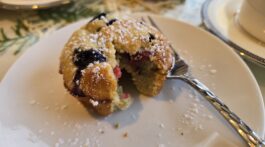









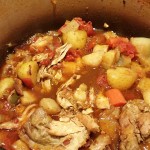
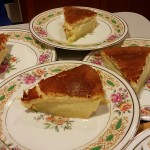
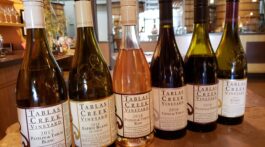
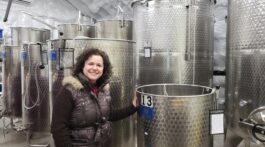

No Comment